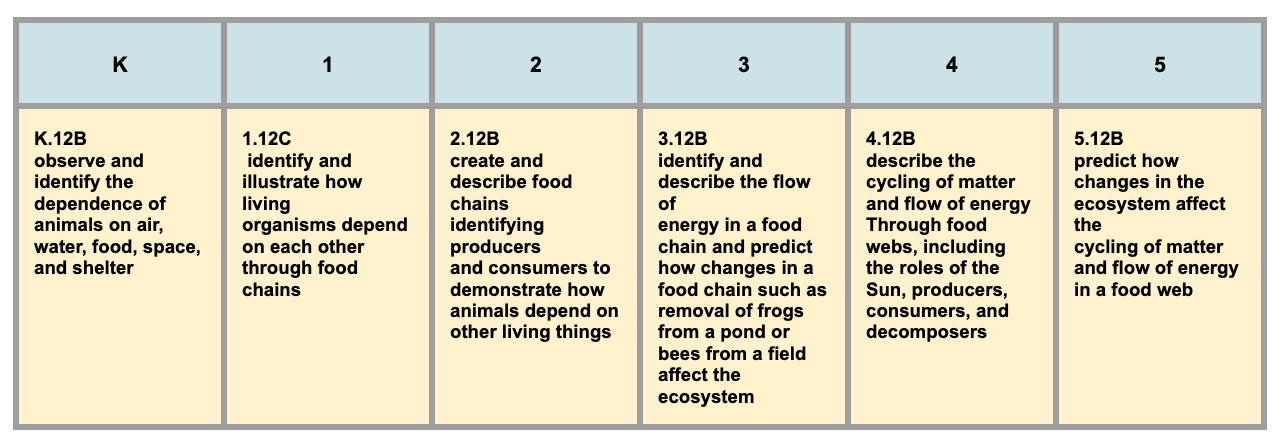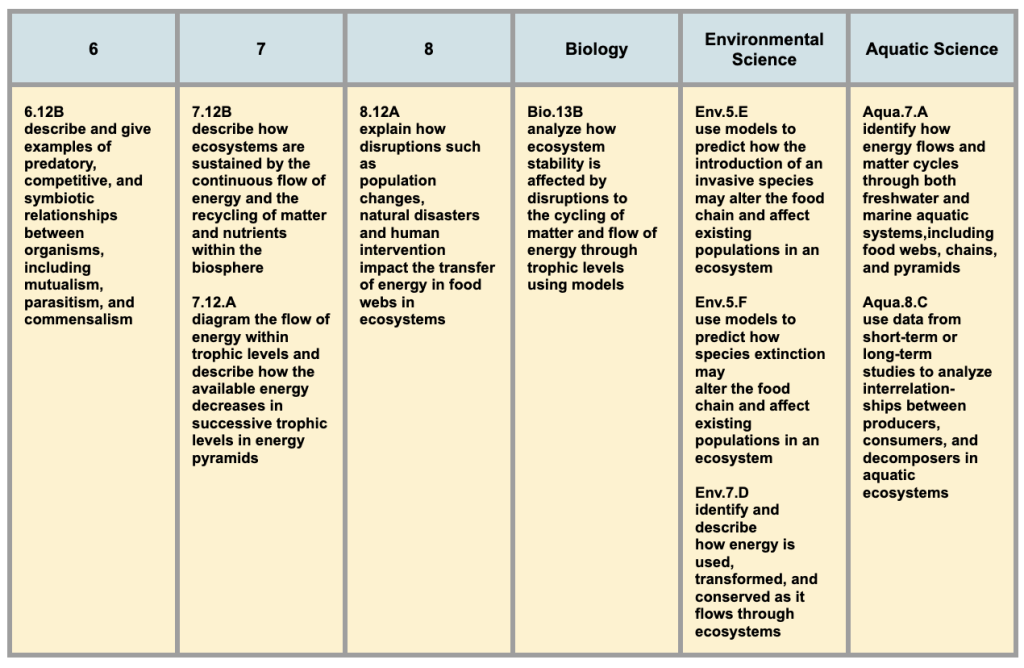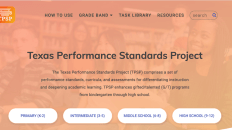Did you know Texas has brand new Science standards? The Texas Essential Knowledge and Skills (TEKS) for grades Kindergarten through 12th have been revised, approved by the State Board of Education, and will be implemented in the 2024-2025 school year. You may be wondering, “How has the Science TEKS changed?” Three key areas of change to the Science TEKS include vertical alignment, scientific and engineering practices (SEPs), and Recurring Themes and Concepts (RTCs). Let’s take a look at these areas of change along with examples.
Vertical Alignment
First in the revision process were grades 9 through 12 TEKS. Revisions for Kindergarten through grade 8 followed.
Starting with the end in mind, which in this case is high school, provides alignment opportunities as one works their way down to Kindergarten.
See the tables below for examples of the new TEKS vertical alignment.
Kindergarten through 5th Grade Vertical Alignment with Organisms and Environments

6th Grade through High School Vertical Alignment with Organisms and Environments

The TEKS revision process aimed to align concepts and skills throughout the grade levels wherever possible.
Scientific and Engineering Practices (SEPs)
Our current Science TEKS has Scientific Investigation and Reasoning standards also called Process Standards.
Our new TEKS have replaced these standards with Scientific and Engineering Practices (SEPs). Think of SEPs as “behaviors of a scientist”.
An intentional effort was made in Kindergarten through High School for students to take on the qualities of a scientist. Below is an example of SEPs within grades 6th, 7th, and 8th.
6th Through 8th Grade SEPs
The wording for SEPs TEKS 2.2 is the same for grades 6, 7, and 8.
2 Scientific and engineering practices. the student analyzes and interprets data to derive meaning, identify features and patterns, and discover relationships or correlations to develop evidence-based arguments or evaluate designs. The student is expected to:
2.2A Identify advantages and limitations of models such as their size, scale, properties, and materials
2.2B Analyze data by identifying any significant descriptive statistical features, patterns, sources of error, or limitations
2.2C Use mathematical calculations to assess quantitative relationships in data
2.2D Evaluate experimental and engineering designs
Rather than isolating science and engineering from one another, the new TEKS brings them together for students through actionable behaviors.
Recurring Themes and Concepts (RTCs)
Themes and concepts are not totally new to the Science TEKS. However, they are taking a more prominent place within our new TEKS.
Specific standards have been created representing RTCs for Kindergarten through 8th grade. These standards help students engage in cross-cutting concepts such as patterns and systems. Here is an example of RTCs found within Kindergarten, 1st, and 2nd grade.
Kindergarten Through 2nd Grade RTCs
Wording for RTCs TEKS 5.5 is the same for grades Kindergarten, 1, and 2.
5 Recurring themes and concepts. The student uses recurring themes and concepts to make connections across disciplines. The student is expected to:
5.5A Identify and use patterns to describe phenomena or design solutions
5.5B Investigate and predict cause-and-effect relationships in science
5.5C Describe the properties of objects in terms of relative size (scale) and relative quantity
5.5D Examine the parts of a whole to define or model a system
5.5E Identify forms of energy and properties of matter
5.5F Describe the relationship between the structure and function of objects, organisms, and systems
5.5G Describe how factors or conditions can cause objects, organisms, and systems to either change or stay the same
Kindergarten through 8th-grade teachers may notice that content-specific standards begin with the number five in the current TEKs. For the new TEKS, content-specific standards begin with the number six since RTCs now have their own place within the standards.
Vertical Alignment, SEPs, and RTCs are part of the big picture in getting a handle on the new Science TEKS. Are you curious about content-specific changes from Kindergarten through High School? In the next blog, we will highlight a few of these changes.
Conclusion
For now, jump in for a deeper dive into the new Science TEKS by attending one of our teacher cohorts!
During the cohorts, we compare the current TEKS to the new TEKS and discuss possible implications. Big takeaways include various documents to support your Science TEKS transition for the 2024-2025 school year. Visit our workshop catalog for cohort dates and information
The Region 13 Science webpage is a great place to see the latest resources and events. Be sure and subscribe to the monthly Science newsletter to stay up-to-date on the latest news and developments.







Add comment